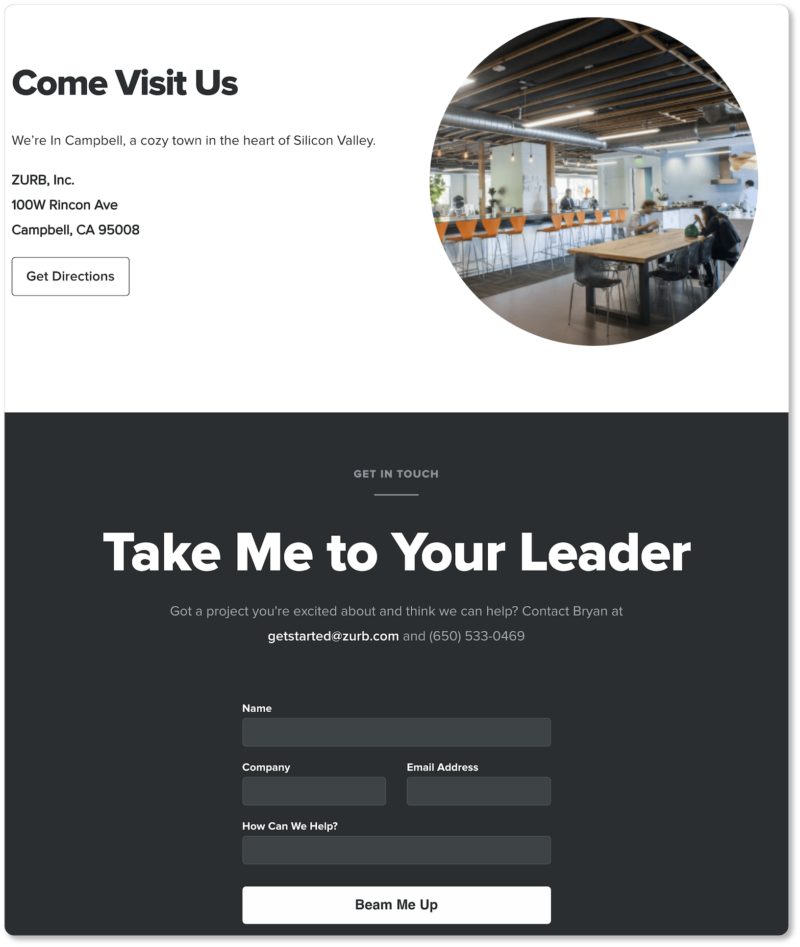One of the most important functions of a website is to make it easy for the public to get in touch with you. Some companies go to great lengths to avoid people getting in touch with them (e.g. PayPal, Facebook), but for most organisations, it’s important that people can contact them.
My golden rule about web design is to make things as simple as you can. The Internet is fiendishly complex – there is no point in making it any more complex than it needs to be – so it pays to use the most low-tech approach you can that satisfies your business needs.
For most businesses, it’s enough to put your phone number, postal address, and email address on your contact page. If you like visuals, maybe you can embed a Google map on your contact page with your location highlighted.

(Thanks Zurb.com)
But sometimes publishing this simple contact information is not enough.
For example, you might want to:
- Record all the details of people who contact you in a database automatically.
- Get specific information from them, e.g. what make or model of product they are asking about, or what region they are in.
- Find out quickly what department the query should be sent to, e.g. is it a sales, support, or a finance inquiry?
- Get specific contact details from them, e.g. their phone number, their company name, their job title.
- Analyse the pages on your website that are generating the most enquiries.
If any of these are really important to you, then the simplest way to get this information out of people is to get them to fill in a contact form on your website. But remember the golden rule above – simpler is better – and introducing a form adds complexity to your website and can bring a host of problems if you don’t plan ahead.

Here are some common pitfalls to watch out for, with some solutions. Try to build these into the form from the start, and you will save yourself a lot of faffing around.
- Spammers are submitting the form. Spambots love forms. They cruise around the web, filling in every form they come across, 24/7 every day of the year. A form is a much more effective way to spam someone than emailing them. If it’s an email, it will likely get filtered by the recipient’s mail provider and go into their spam folder. But a form doesn’t offer any such protection.
- Solution: use a CAPTCHA on your form so only humans can submit it. A good example is Google’s reCAPTCHA.
- The contact details you’re capturing are not authentic. If someone fills in a form, mistypes their email address and doesn’t add any other contact details, then you have no way of getting back to them. Or they might deliberately give you the wrong email address because they are worried that you will start sending them spam.
- Solution: there is no 100% way to guarantee that an email address is correct, but you can easily check if the address is valid (i.e. it is of the form xxxx@xxxx.xx).
- You’re not getting much valuable information from the form. Make the really important fields like name, email, phone number, message, required fields. If they don’t fill these in, they don’t get to submit the form.
- Hardly anyone is using the form. You need to make it easy for someone to fill the form in. The form needs to look smart, make sense, and work well on mobile devices. If they make a mistake, e.g. leave out a required field, or mistype their email address, you should warn them in a way that makes it very clear what they need to do to fix it. And don’t wipe all the information they have already entered!
- Hardly anyone is using the form, part 2. You need to make it quick for them to fill the form in. If you ask them to fill in 10 fields, they might get bored and leave halfway through.
- Solution: ask for the bare minimum of information that gives you enough to decide whether it’s a legitimate enquiry and what your next steps should be.
- The info going into my CRM doesn’t look right. If you’re using the form for inputting details into a database, e.g. a CRM like Salesforce or marketing automation tool like Hubspot, then you’ll need to consult the documentation for the system to ensure that your form is coded correctly, and test the hell out of it. These systems can be expensive and if you’re not getting the right data into them, you can waste a lot of money.
- My analytics reports don’t match up with what we’re seeing coming through. If you’re using the form to analyse what pages are producing the most enquiries, then you need to set up your analytics software correctly. Google Analytics is a common platform for this sort of thing. GA allows you to set up goals like form submissions pretty easily, but you need to consult their documentation to ensure the tracking is accurate. You don’t want to be counting all those spambots and half-filled in form attempts as legitimate enquiries, do you? No, of course not. So follow all the tips above before you even think about using form submissions to measure your digital marketing success.
- Solution: the easiest way to track form submissions in Google Analytics is by adding a ‘thank you’ page, which shows after they successfully submit the form. This requires almost no in-depth knowledge of Javascript and the other things that trip up most amateurs.
Right. That’s a fair bit to think about. But that’s OK. If you need a form, then like any aspect of web development, a little bit of time spent in planning goes a long way.

Before you rush into adding a form to your site, don’t forget that the humble email link is a very powerful way of getting information from people.
- You can be almost certain that you’ll only get legitimate enquiries (the rest will go into your spam folder).
- You’ll get a whole lot of extra valuable information from their email signature. Usually their job title, physical address, mobile, landline, and company name. Maybe even all the awards they have won.
- It’s much easier for people to send you an email than fill in a form, especially on a mobile phone. So you’ll probably get more enquiries.
- People can send you files as attachments if they email you. If you don’t have a file upload in your form, they can’t do this.
If you need any more information about this (or any other topic in digital marketing) let us know. You can fill in a form or send us an email. It’s up to you!
